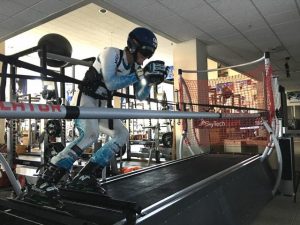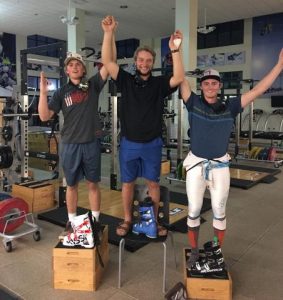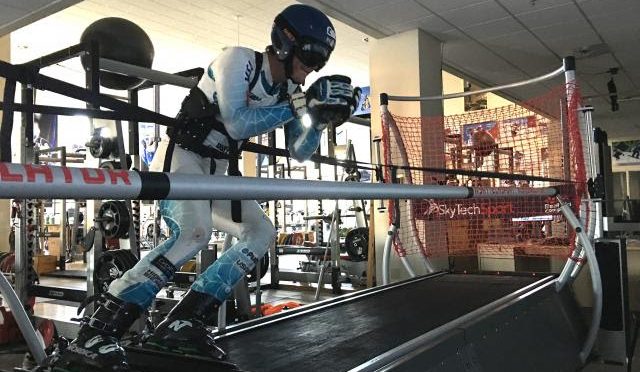Park City, UT – Even after spending all day in the gym, the Europa Cup boys on the U.S. Alpine Ski Team returned to the U.S. Ski and Snowboard Association (USSA) Center of Excellence in Park City on a Thursday night in September. It was a festive atmosphere with pizza and loud music, but the guys weren’t quite dressed for a party. Instead, they all showed up in their downhill suits.
The Center of Excellence gym—full of elite skiers and snowboarders gaining strength for the upcoming season—houses a ski simulator designed by SkyTech. The athletes put on their ski boots and step into the bindings. There are sensors everywhere—tracking movement, angles, the position of skis and more. They’re on a motor that generates forces and the sensation of skiing. In front of them is a World Cup track filled with gates—an actual World Cup course filmed in previous seasons—allowing the skier to train a hill over and over, prior to actually racing it on snow.

While the ski simulator is an amazing tool, it requires quite a bit of setup, so it isn’t used all the time. But Strength and Conditioning Coach Mike “Bing” Bingaman put in the effort to set it up for a virtual downhill race, as a reward for the Europa Cup team after a summer of hard work.
“The idea sparked when I had both Drew Duffy (Warren, Vt.) and River Radamus (Edwards, Colo.) on the ski sim and I saw how competitive they’d get with one another when training downhill,” said Bing. “I thought it’d be a blast to set it up one night and host a full-on race.”
Bing designated athlete Erik Arvidsson (Woodside, Calif.) as the race coordinator and he made a legitimate ski program. Ten of the guys signed up—eight athletes and two coaches—and they raced the 2018 Olympic downhill track in South Korea. The order was even designated by a bib draw. The set up consisted of two consecutive training runs per athlete with the “officials” recording the best of two. The training run times were flipped for the official run order. The best time went last; the worst time raced first. Each athlete had two consecutive official runs, with the best of two recorded.
It was a three-hour event, with Florian Szwebel (Avon, Colo.) nailing first place. Behind him, National Training Group athlete Jimmy Krupka (Waitsfield, Vt.) was second and Duffy took third.

“It was intense! River had the fastest training run and was the last racer of the night,” relayed Bing. “As he ran through the first four splits, his lead was increasing, but on the backside of the course, he hit a gate, solidifying Florian as the 2016 Ski Sim World Cup Champion.”
“It feels great to win against such a strong field,” Szwebel said after his win. “Our team is very competitive in all our training—on and off snow—so naturally there was a lot of intensity on the ski simulator. This was actually my first time using the new simulator so the win was a little surprising, but it’s a great tool that I look forward to using more in the future.”
Will we see Szwebel, Krupka and Duffy on the podium at Europa Cups this season, or perhaps at the PyeongChang Olympics, after running the course so many times? Only time will tell.

